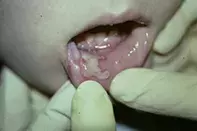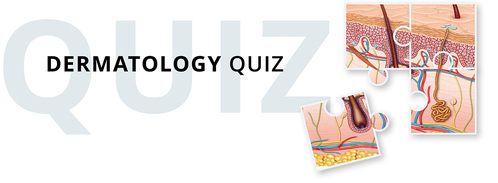What’s the diagnosis?
A young boy with a painful oral ulcer

Case presentation
A 6-year-old boy presents with a large oral ulcer that developed three days ago and has been slowly enlarging (Figure 1). The lesion is shallow but very painful.
Diagnosis
This is a large aphthous ulcer. Aphthous ulcers are common in children but can occur in patients of any age and are typically painful. They develop on mucous membranes and have a characteristic morphology, being round to oval in shape with a grey-yellow sloughy base and an erythematous border. This boy’s lesion is unusual given its irregular margin and large size, but it has the typical morphology of an aphthous ulcer. It is a spot diagnosis.
Aphthous ulcers are the most frequent cause of ulceration on mucous membranes. They are generally localised, acute, recurrent and painful. This patient’s ulcer would be classified as a major aphthous ulcer, based on its size (Table). Major aphthous ulcers are large and often solitary, and they take longer to heal than minor aphthous ulcers.
Table. Comparison of minor and major aphthosis |
||
|---|---|---|
| Characteristic | Minor aphthosis | Major aphthosis |
|
Number of ulcers |
1 to 6 |
1 to 6 |
|
Size (diameter) |
<10 mm, usually 2 to 6 mm |
1 to 3 cm |
|
Percentage of cases |
90% to 95% |
5% to 10% |
|
Duration |
7 to 10 days |
Up to 6 weeks |
|
Resolution |
No scarring |
Potential for scarring |
|
Pain |
Less painful |
More painful |
|
Location |
Nonkeratinised surfaces, especially lips, buccal mucosa and tongue (sulci and ventrum) |
Any area of oral mucosa, including keratinised surfaces |
Aphthous ulcers usually involve the lips, buccal mucosa and tongue, with large lesions sometimes affecting keratinised mucosa. They tend to heal within two weeks but large ones can last up to six weeks. Some patients suffer from many recurrent attacks of these ulcers every year, whereas others experience them much less frequently.
Although oral aphthae are well known, it is less well appreciated that aphthous ulcers can occur on the mucosa of the genital region. This is referred to as nonsexually acquired genital ulceration (NSAGU), previously known as Sutton’s ulcer, Lipschutz ulcer, ulcus vulvae acutum and complex aphthosis. NSAGU is more common in women and is characterised by acute painful genital ulceration that can also be associated with oedema of the labia minora. Genital aphthae have the same characteristic appearance as oral aphthae: a shallow or deep ulcer with a grey-yellow base and surrounding erythema. They vary from about 2 mm to 2 cm in size.1
Pathogenesis
The pathogenesis of aphthous ulcers is not well understood but there is believed to be a hereditary component. Associations with food, medications, allergies, stress and haematological and immunological disorders have been reported, but there is not strong evidence for these. Patients may report aphthous ulcers appearing at the time of smoking cessation.2
Differential diagnosis
Conditions to include in the differential diagnosis of this case include the following:
- Crohn’s disease. Significant oral involvement occurs in 10 to 15% of patients with Crohn’s disease, usually in people at the severe end of the spectrum of Crohn’s disease. Other lesions of the oral cavity that could be present include angular cheilitis, cobblestoning of the buccal mucosa and painless lip swelling.
- Behçet’s disease. This rare, chronic, multisystem disorder is characterised by recurrent genital ulceration, oral ulceration and inflammatory disease of the eye. Cutaneous lesions also occur. An autoimmune inflammatory condition, it usually begins between the ages of 10 and 45 years (mostly in patients aged in their 30s and 40s). Behçet’s disease would be highly unlikely in this patient, given his age and the absence of genital ulceration, eye involvement and cutaneous lesions.
- Coeliac disease. Oral lesions may occur in patients with coeliac disease, and it is an important diagnosis to exclude. Oral features of coeliac disease include aphthous ulcers, angular stomatitis and dental disease; at times these may be the only features.
- Periodic fever adenitis pharyngitis aphthous ulcer (PFAPA) syndrome. This is the most common type of recurrent fever syndrome and is characterised by aphthous ulcers on the lips or buccal mucosa, which are not painful and tend to be small and not scar. It commonly begins in children aged between 2 and 6 years, but it is unlikely in this scenario because of the absence of other clinical findings such as pharyngitis, cervical adenitis, periodic fever and nonconstitutional symptoms such as malaise and headache.
- Cyclical neutropenia. Aphthous ulcers are frequently present, but children commonly experience symptoms such as fever, malaise, bacterial infections and gingivitis.3 There is often premature tooth looseness and tooth loss due to inability to fight infection. Cyclical neutropenia would be unlikely in this scenario because the cyclical symptoms would have usually appeared well before the age of 6 years.
- Herpes simplex virus (HSV) infection. HSV is a common cause of infection in the oral cavity. A child with a primary infection would present with systemic features such as malaise, anorexia, irritability, fever and cervical lymphadenopathy. There can be vesicle formation in the oral cavity (usually multiple) and round or ovoid ulcers (1 to 3 mm in diameter) affecting the oral mucosa and gingival. There is also vesiculation and rapid progression into multiple, small and discrete ulcers in the oral cavity. It is unlikely to be the diagnosis in this patient, who has a single, discrete and slowly enlarging ulcer.
Investigations
A diagnosis of aphthous ulcer is made on a clinical basis; there is no specific diagnostic test available. A biopsy of an aphthous ulcer is nonspecific, revealing only loss of epithelium and a chronic mixed inflammatory infiltrate, and is therefore not indicated. It is rare that a patient will need any testing. If, however, there are any concerning symptoms for any of the conditions mentioned above then investigations for these can be undertaken. In practice, the only initial investigations likely to be necessary for a child who is otherwise well would be a swab of the ulcer to exclude HSV, a full blood count with inflammatory markers, and coeliac serology.
Management
For mild aphthous ulcers, the mainstays of treatment are avoidance of exacerbating factors (if any), analgesia and topical measures. Carmellose sodium paste and other topical analgesics can be effective. Topical corticosteroids suppress inflammation and reduce pain; these were used to treat the patient described above. For patients with more severe disease, referral to a dermatologist is recommended. Systemic treatment may be appropriate and include oral prednisone, doxycycline and, in a child, erythromycin. Other treatments that have been advocated for aphthous ulcers include colchicine and dapsone. The use of all medications for aphthous ulcers is off label.
References
1. Dixit S, Bradford J, Fischer G. Management of nonsexually acquired genital ulceration using oral and topical corticosteroids followed by doxycycline prophylaxis. J Am Acad Dermatol 2013; 68: 797-802.
2. McBride DR. Management of aphthous ulcers. Am Fam Physician 2000; 62: 149-154.
3. Palmer SE, Stephens K, Dale DC. Genetics, phenotype, and natural history of autosomal dominant cyclic hematopoiesis. Am J Med Genet 1996; 66: 413-422.
Skin lesions

